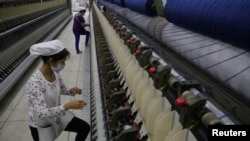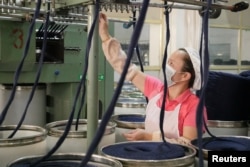In Hong Kong, more than 340 tons of textile waste is dumped each day into the city's overflowing landfills, according to the city's Environmental Protection Department.
But a new textile spinning mill, the first to open in this former textile manufacturing powerhouse in half a century, aims to reuse that waste, harnessing pioneering recycling technology to try to make the fashion industry more sustainable.
"These technologies may be the gateway to a fashion industry decoupled from the use of virgin natural resources," said Erik Bang, who heads innovation efforts for the H&M Foundation, a nonprofit funded by the family, founders and main owners of H&M Group.
The clothing retailer has already placed a first order at the mill, as part of its bid to become "fully circular and renewable," according to Cecilia Brännsten, the group's environmental sustainability manager.
The Novetex Upcycling Factory in Tai Po Industrial Estate, when it opens this month, will use new technology to separate fabric blends in waste garments and produce yarn.
It comes as clothing companies around the world doubled the amount of garments they made from 2000 to 2014, according to a 2016 report by management consultancy McKinsey & Co.
Over the same period, the number of garments bought each year, per person, jumped 60 percent, the report said.
That has led to a stream of clothing — purchased and thrown away, left unsold, or tossed as textile plant waste — going into landfills.
Curbing 'take-make-dispose'
The government of Hong Kong wants to encourage its 7.3 million people to move away from a "take-make-dispose" model toward a more "circular economy" where waste is reused, according to Kam-sing Wong, the city's secretary for the environment.
It is also seeking to make the city a leader in sustainable fashion.
To try to achieve the aim, it has since 2006 funded the Hong Kong Research Institute of Textiles and Apparel (HKRITA), which collaborates with industry partners and groups like the H&M Foundation.
Hong Kong's government also funded a two-day "Fashion Summit" in early September, billed as the largest sustainable-fashion event in Asia.
With many people working in textile sourcing and startups, the city is a good place to introduce new technology to a global audience of fashion executives, according to Yan Chan, director for business development at the HKRITA.
Fashion companies "are making decisions here. So once the technology is actually ready, then we can spread out across not only Asia but all over the world," said Chan.
The new mill in Tai Po uses two pioneering technologies, developed and patented by HKRITA, to reuse fabric made of mixed fibers.
While it's possible to recycle garments made from one material, until now no commercially viable method has existed for recycling blends on a big scale, Chan said.
The mill will carry out mechanical recycling, where soiled or damaged fabrics — such as old uniforms or hotel curtains — are sanitized, with buttons and zippers removed, then sorted and stored.
Once an order comes in for a certain color, the material is UV-sterilized before being cut into pieces and spun into yarn.
No water or dye is needed, and only small amounts of virgin material are used, Chan said.
But the mill will also test a system to separate cotton and polyester blends using only heat, water and a small quantities of biodegradable chemicals.
The cotton is turned into cellulose powder while the polyester fiber is used for spinning and making new fabric, Chan said.
If Novetex can show on the factory floor that the technologies work to make high-quality yarn, it could drive demand globally for recycled yarn and wider use of the technology, its backers say.
"As we scale up and make this technology freely available to the industry, we will reduce our dependence on limited natural resources to clothe a growing global population," Bang said.
Fast fashion
A 2017 report from the Ellen MacArthur Foundation, a U.K.-based sustainability charity, said the total greenhouse gas emissions from producing textiles, at 1.2 billion tons annually, are more than those from all international flights and maritime shipping.
An average of 23 kilograms of greenhouse gases are generated to make one kilo (2.2 pounds) of fabric, according to McKinsey.
Customers are keeping their clothes half as long as they did 15 years ago, the report added, sometimes wearing them only seven or eight times before disposing of them.
This move toward fast fashion — where more clothes are produced but at a lower quality, making them less robust — must be reversed for a sustainable future, researchers from the Mistra Future Fashion program wrote in The Handbook of Sustainable Fashion.
A sustainable fashion survey by auditor KPMG, released at the Fashion Summit this month, showed more buyers are becoming more conscious about the industry's impact on the planet.
More than three-quarters of 5,000 consumers surveyed in Hong Kong, Shanghai, London, New York and Tokyo said they were concerned about the environment, pollution and waste.
However, only 13 percent of consumers in the survey said they were willing to pay a higher price for sustainable fashion.
Sixty percent said they would prefer sustainable fashion if the price was the same as that for normal fashion. A labeling or scoring system would help, they said.
To help educate consumers and entice them to recycle clothes, HKRITA, Novetex and the H&M Foundation have teamed up with a repurposed former textile mill complex called The Mills in Hong Kong and opened a recycling station and shop in the western New Territories' neighborhood of Tsuen Wan.
Here, Hong Kongers can bring in old, unwanted clothes and ask them to be remade into another garment, in as little time as four hours.
"Seeing is believing, and when consumers see with their own eyes what a valuable resource garments at end of life can be, they can also believe in recycling," Bang said.











